Anna Coleman Ladd: The Sculptor Who Healed the Faces of War
When World War I left thousands of soldiers with faces they could no longer recognize, one sculptor decided to help them face the world again. Anna...
Wen Gu 10 November 2025
6 October 2025 min Read
Lavish banquets, appetizing cakes, savory Dutch cheeses, and colorful fruits elegantly arranged on fine china come to mind when we think of Clara Peeters’ art. If you love both food and art, let’s explore the delicious world of Clara Peeters’ still life paintings.
Extremely little is known about Clara Peeters’ life. She was one of the few women who was able to devote herself professionally to painting in the 17th century, obtain commercial benefits from it, and gain recognition for her work. Despite not having been as well known as her male contemporaries for a long time, Clara Peeters was not only one of the most outstanding painters of the Dutch Golden Age but also a pioneer in the still-life genre.
Based on a baptismal register, she is believed to have been born in Antwerp in 1594 (although the year is debated). Clara Peeters developed her painting career between the years of 1607, the date of her first painting, and 1621. She was active in Antwerp, and later the Netherlands, during the 17th century—a period of great cultural and economic flourishing. She was a contemporary of painters such as Peter Paul Rubens, Anthony van Dyck, Frans Snyders, and Jan Brueghel the Elder.
Although we do not know much about her artistic training, due to the quality of her work, it is unlikely that she was self-taught. Some art historians point out that she may have studied in the circle of Jan Brueghel the Elder, while others suggest that Osias Beert could have been her teacher, since Clara Peeters’ works are stylistically similar to his own.

Clara Peeters, Still Life with Flowers, a Silver-gilt Goblet, Dried Fruit, Sweetmeats, Bread Sticks, Wine, and a Pewter Pitcher, 1611, Museo del Prado, Madrid, Spain.
Clara Peeters devoted herself mainly to still life painting, becoming one of its greatest exponents. During a period when women’s roles were largely limited to home and family life, Peeters overcame the restrictions imposed on her and, as her paintings show, transformed these limitations into an asset for her art. Her paintings are a faithful testimony of the diet of 17th-century Holland and the economic and commercial relations of the Low Countries.

Clara Peeters, Still Life with Cheeses, Almonds, and Pretzels, c. 1615, Mauritshuis, The Hague, Netherlands.
In Still Life, with Cheeses, Almonds, and Pretzels, placed on a pewter plate, three types of cheese stand out: one darker, Edam-type cheese; the largest, surely Gouda; and the smallest, triangular in shape, made from sheep’s milk. Above them, to accompany the cheese, there’s a plate of butter. In the 17th century, the Netherlands was not only a major consumer of cheese but also a major producer for exporting to other European countries. Clara Peeters’ works thus reflect not only daily life in the Netherlands but also its trade relations. We can appreciate Clara’s mastery of the textures and surfaces by looking at how the porous interior of the cheese contrasts with its smooth outer crust.
In the foreground, pretzels sit alongside a silver knife, seemingly protruding from the table, and a blue-and-white porcelain plate holding almonds, figs, and raisins. The knife bears the artist’s name—a clear statement of authorship. The plate on which the dry fruits are placed is a Chinese porcelain piece known as kraak, made in the province of Xiangxi, a symbol of Dutch trade with China in the 17th century. In the background, we find a ceramic jug, and on the right, next to a small bread roll, a Venetian glass cup in the à la façon de Venice style. The carefully crafted cup also reflects trade, as the presence of Venetian glassblowers in Antwerp is well documented.
If we look closely at the painting, there is a small detail that immediately catches the eye. In addition to the artist’s signature on the knife, there is another subtle symbol of authorship: a self-portrait hidden on the lid of the jug! Self-portraits are a recurring feature in Peeters’ work, serving as a way for her to assert her authorship!
Clara Peeters was a master at depicting the material and food culture of her time, particularly that of the elites. In Table with a Cloth, Salt Cellar, Gilt Tazza, Pie, Jug, Porcelain Dish with Olives, and Roast Fowl, she presents a lavish banquet, brimming with abundance, luxury foods, and precious materials. The artist meticulously paints the linen damask tablecloths—a valuable item exported from Flanders to the rest of Europe—capturing even the creases from where the cloth had been folded. Every element and food item signals to the viewer that we are in a wealthy household, likely belonging to the social elite.
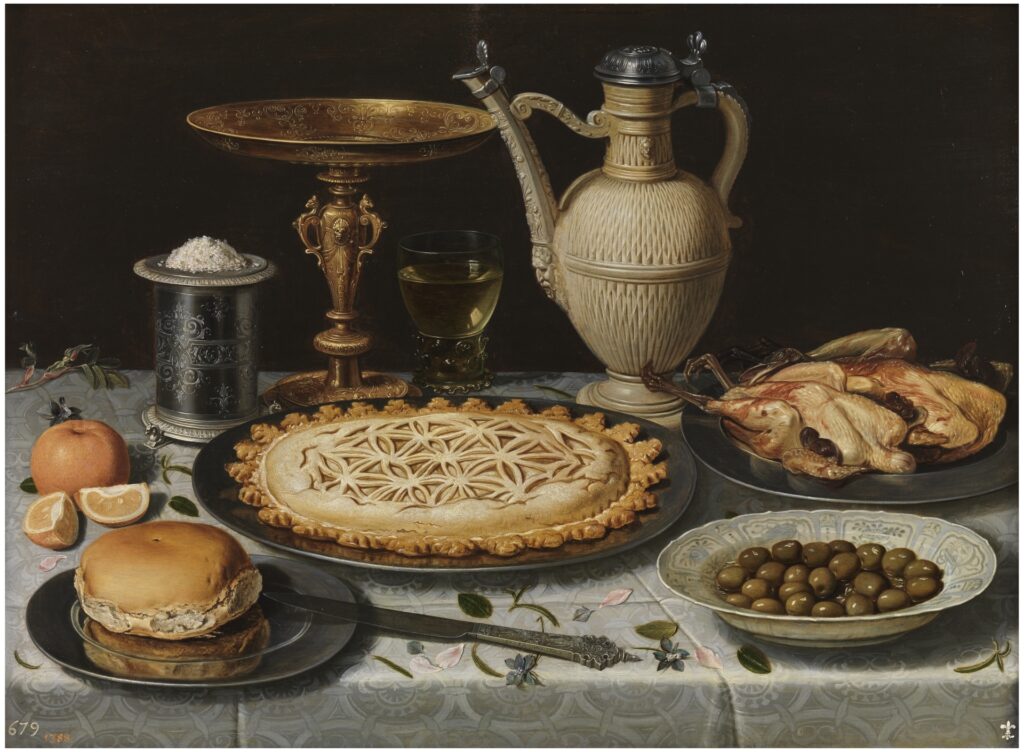
Clara Peeters, Table with a Cloth, Salt Cellar, Gilt Tazza, Pie, Jug, Porcelain Dish with Olives, and Roast Fowl, c. 1611, Museo del Prado, Madrid, Spain.
The Chinese porcelain plate is filled with olives from Spain, a luxury for northern Europe at the time. The colorful oranges, probably imported from Italy, Spain, or Portugal, add an extra touch of luxury to the table. Even the salt cellar and the birds on the pewter plate, possibly pheasants, signal the household’s wealth—salt was expensive at the time, and game birds were a luxury. There is also a cake on the table, possibly filled with fruit, fish, or meat, which echoes the net pattern of the ceramic jug behind, adding dynamism to the composition.
The golden tray and the glass cup further demonstrate Clara Peeters’ mastery—we can even glimpse the reflection of the window in the glass. At the very front of the table, we find a knife with the painter’s name as well as the mark of the city of Antwerp. The city mark situates the painting within its social and geographical context.
Even though we are used to the deeper, sometimes hidden, meanings of still life paintings, in the 17th century, we see a growing interest among artists in the materiality and naturalism of objects. There is a clear desire to study nature for its own sake rather than to confer upon it a transcendental meaning. At first glance, Clara Peeters seems to align with this new artistic trend, directly observing material reality, yet in her work, both approaches to still life coexist. In Still Life with Dainties, Rosemary, Wine, Jewels, and a Burning Candle, we can sense that a more subtle meaning lies beneath the surface.
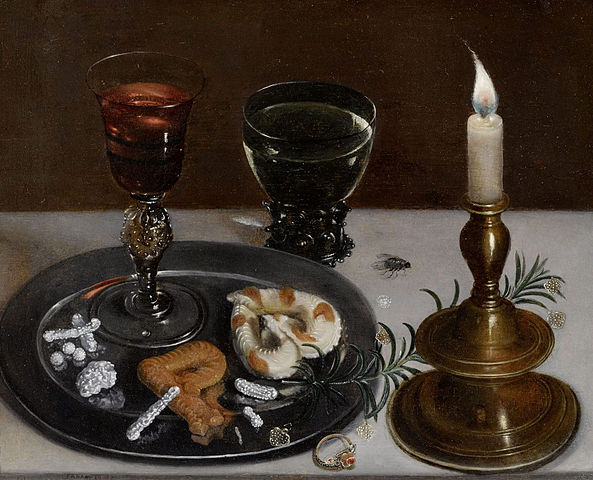
Clara Peeters, Still Life with Dainties, Rosemary, Wine, Jewels, and a Burning Candle, 1607, private collection.
The elements that appear to be randomly placed invite us to interpret this painting symbolically. Beyond the wine glasses and the candles—both common in vanitas paintings—we see on a silver tray several almond-paste sweets, a typical delicacy of the time. We cannot overlook the cross, heart, and P shapes of the biscuits. The P is almost certainly a reference to the painter herself, serving as a subtle signature. As we will see below, Peeters had a well-known taste for self-portraits and self-references.
On the table lies a sprig of rosemary, from which strawberry-shaped earrings hang, and in the foreground rests a ring. While strawberries were associated with fertility, sprigs of rosemary were often placed on wedding tables and used in wedding processions. Together with the ring and the heart-shaped biscuit, these botanical elements clearly suggest that the painting was created to commemorate a wedding.
This painting is a pure abundance. A wooden basket brims with fruit—grapes, pears, apples, plums, cherries, and apricots—a feast for both taste and sight. A fly perched on the apple adds further realism to the work. In the foreground lie several dead birds, including a kingfisher, bullfinches, and a parrot. Unlike many of Peeters’ other works, where ochre and brown tones predominate, this scene bursts with color, dominated by the complementary red and green fruit and the birds’ plumage.
On the right, a small monkey hungrily cracks a nut, adding a playful touch. Together with the parrot, this exotic creature reflects the period’s fascination with the rare and the foreign. Their presence in a Dutch setting also points to the Netherlands’ trade connections with regions of Central and South America.
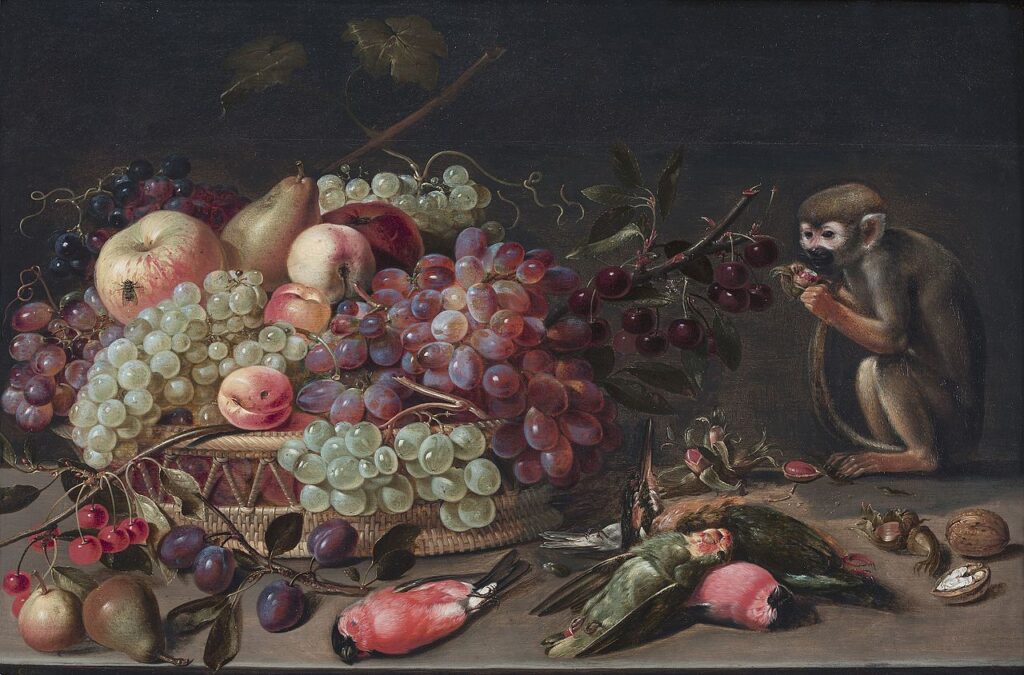
Clara Peeters, Still Life of Fruit, Dead Birds, and a Monkey, c. 1615–1621, private collection.
This work differs from Peeters’ usual paintings. In Still Life with Flowers and Gold Cups of Honour, we do not find the overflowing cheeses, fruit baskets, or sumptuous spreads. Even the bouquet of flowers appears smaller than in other Peeters paintings.
On a stone surface, we find various objects, commonly found in vanitas paintings, arranged randomly. The textures and surfaces of the objects are almost “photographically” rendered. The intense colors of the flowers in the ceramic vase stand out against the black background, as do the luminous, golden cups. Both cups follow the style of 16th-century Nuremberg pieces and are topped by two soldiers resembling “crusaders.”
Next to the cups lie gold coins and a gold chain on a porcelain plate. Next to them are four shells of different origins, colors, and textures. By the 16th century, shells had become prized collectors’ items, often displayed in cabinets of curiosities.
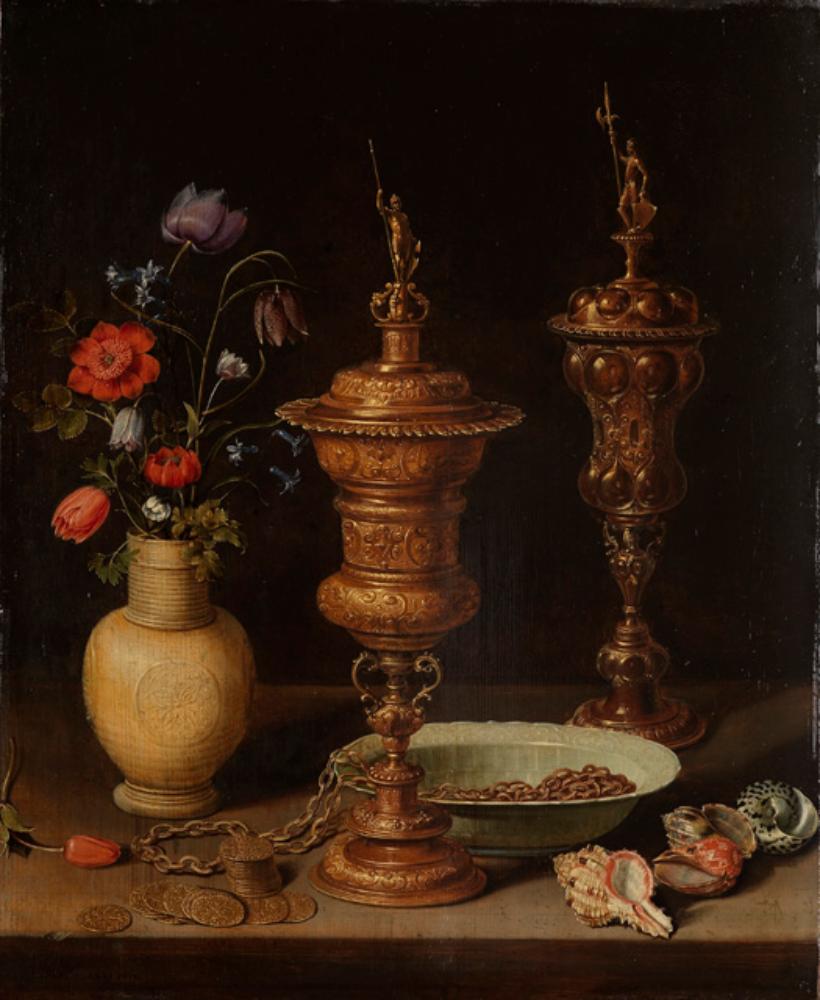
Clara Peeters, Still Life with Flowers and Gold Cups of Honour, 1612, Staatliche Kunstahalle, Karlsruhe, Germany.
But the most intriguing detail of this painting is hidden on one of the cups. If we look closely at the cup on the right, we can spot up to six self-portraits of Clara Peeters!
Although Clara Peeters included self-portraits in other works, this painting contains the most of them. Their inclusion is a bold statement, asserting her authorship in a social context that was challenging for women artists. Moreover, Peeters playfully engages the viewer, creating the illusion that she is painting while we admire her art. Isn’t that brilliant?
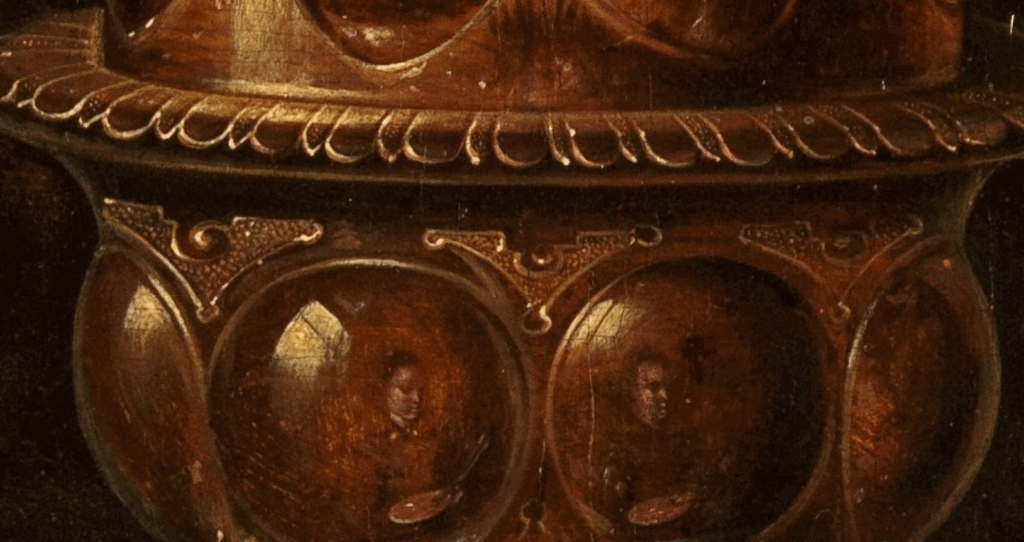
Clara Peeters, Still Life with Flowers and Gold Cups of Honour, 1612, Staatliche Kunstahalle, Karlsruhe, Germany. Detail.
We hope you enjoyed exploring the delicious Baroque world of Clara Peeters as much as we did!
P.S. If you are a fan of still lifes, be sure to check out our Food & Drinks postcards, featuring, among others, Clara Peeters’ work.
Rosa Elvira Caamaño Fernández: “Clara Peeters” in Educación y dedicación. Aportaciones de las grandes pintoras del arte. Desde la antigüedad hasta 1.800, Servizo de Publicacións da Universidade de Vigo, Vigo 2011.
Jane Fortune: “Clara Peeters: Breakfasts and Banquets” in Invisible Women. Forgotten Aritsts of Florence, The Florentine Press, 2010.
Alejandro Vergara: El Arte de Clara Peeters, Museo Nacional del Prado in associaciotion with Koninklijk Museum voor Schone Kunsten, Madrid 2016.
DailyArt Magazine needs your support. Every contribution, however big or small, is very valuable for our future. Thanks to it, we will be able to sustain and grow the Magazine. Thank you for your help!